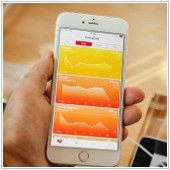 Medical records are generally inaccessible and hard to understand. In fact, if you were to try reading your own medical data, you might find that it’s almost as if it’s in a different language. A medical record can be riddled with cryptic phrases, acronyms and complex terms that mean nothing in the eyes of someone that didn’t study medicine for eight years. Fortunately, with Apple’s iOS 10 new app - HealthKit - you will be able to easily request your personal records, save it and understand personal records with the help of other apps. Here’s a rundown of the app and all of the changes in healthcare technology you can expect to see in the future.
Medical records are generally inaccessible and hard to understand. In fact, if you were to try reading your own medical data, you might find that it’s almost as if it’s in a different language. A medical record can be riddled with cryptic phrases, acronyms and complex terms that mean nothing in the eyes of someone that didn’t study medicine for eight years. Fortunately, with Apple’s iOS 10 new app - HealthKit - you will be able to easily request your personal records, save it and understand personal records with the help of other apps. Here’s a rundown of the app and all of the changes in healthcare technology you can expect to see in the future.
Medical records stored on your phone
With HealthKit, patients will be able to request and store their health information in the HL7 format, which is the standardized format used between healthcare providers and patients. While storing your own medical records in your phone isn’t new, the app will allow you to directly save your physician-created electronic medical record (EMR) data into the app.
This means you will have an updated version of your EMR with you at all times, which can be handy, especially if you are changing hospitals or physicians. Patients can simply share their standardized HL7 formatted records with another healthcare provider and upload the necessary data digitally to their physician, so they’ll be up-to-date on your medical history or any health issues. This also eliminates the need for you to coordinate between hospitals on the migration of your medical records.
By having an automated log of accurate medical information, healthcare providers can track patterns in the patient’s medical history that will allow them to quickly diagnose existing health issues.
Interpret cryptic medical data
Unlike other apps in the market, this built-in app is designed as a medium through which all your relevant medical data can be synced. Since your medical records are given to you in a XML file, the content stored within the document can seem intimidating. However, with data stored in a standardized format, applications can simply tap into the data, share information between different apps and display them in a format that you can easily interpret. For example, a fitness app like Nike+ Running will be able to accurately calculate calories burned because it has up-to-date information about your weight, height, body mass index, as well as other statistics. These apps can also take your EMR and display them on a chart to show any significant developments in your health.
Wearables
With the Apple Watch built-in pedometer, health records can also be automatically and consistently updated. This means things like blood pressure and heart rate can be easily monitored and applied to your EMR, without having to go to the doctor’s office for a checkup.
At the end of the day, the potential for this new technology is still unknown, but it seems to be heading towards a clear direction - making EMR management more convenient for patients.
Contact us today if you are interested in learning more about the latest developments with Apple and their healthcare app.

Leave a comment!
You must be logged in to post a comment.